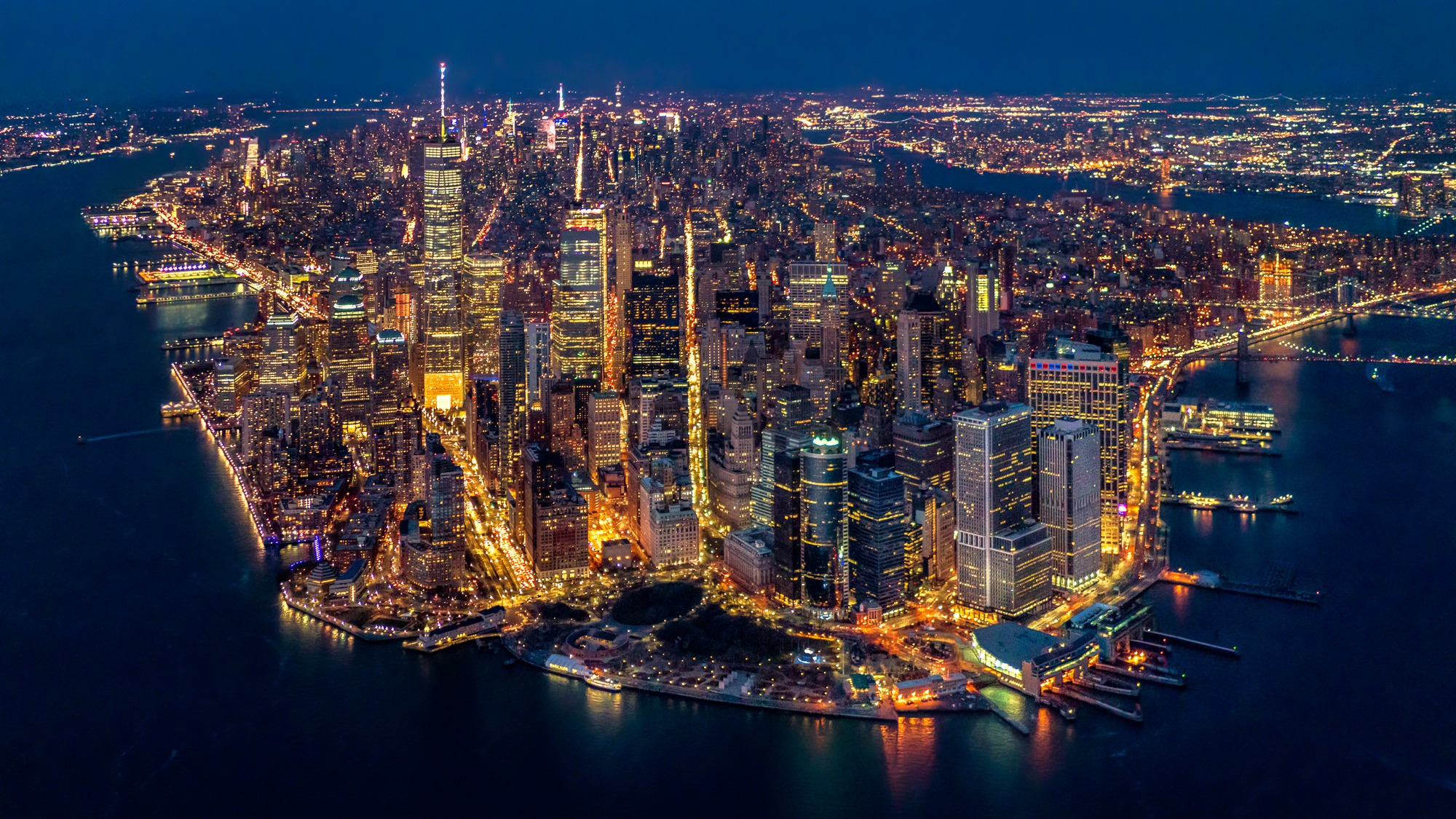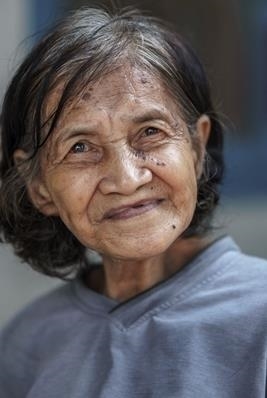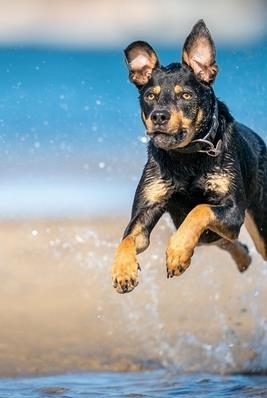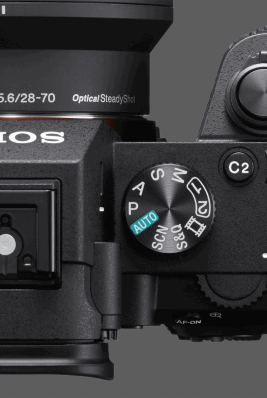While travelling around North America earlier this year with my wife, I had organised a charted helicopter aerial photography flight over Manhattan, New York, during the golden and blue hour lighting phases.
As with most genres of photography, planning and research are critical to a successful shoot.
Low light aerial photography presents a number of interesting challenges which you will need to plan for, in order to overcome these obstacles. After months of research, I composed a shot list and determined that I was going to hire two Alpha 7R II’s with the Sony FE 24-70mm ƒ/2.8 GM Lens and the Sony Distagon T* FE 35mm ƒ/1.4 ZA Lens. But of course, no matter how well you plan, problems you could have never considered tend to arise.
So here’s what I learnt

1. Shoot Wide Open
It may surprise you to know that for the entire flight, I shot both the 24-70 ƒ/2.8 and 35mm ƒ/1.4 wide open. When photographers shoot landscapes, they will usually stop down their lens in order to maximise depth of field. Fast, wide angle glass is typically used by photographers who either want a shallow depth of field or for astrophotography. Much like astrophotography, when you are shooting from a helicopter, your distance from the focal point is so great that even at ƒ/1.4, the majority, if not all of the scene, is in focus. This allows you to lower your ISO and increase your shutter speed, reducing noise and motion blur.
Although shooting wide open has its advantages, there are drawbacks. As I had never used the 35mm prime lens before, I was unaware of how much vignetting was present at ƒ/1.4 until I opened the files up in Lightroom. Although this can be easily fixed with the click of a button, this is going to add more noise to the corners of your images. The majority of lenses do not perform at their best until they are stopped down. If you are planning on shooting into the golden hour or blue hour like I did, I would recommend using high quality, fast primes and stopping down around 1/3rd of a stop, if there is sufficient ambient light to do so.

2. Base Your Lens Selection on the Lighting Event You Plan Your Flight Around
This may vary from company to company but when you fly with the doors of a helicopter removed, you cannot switch lenses for safety reasons. This makes lens selection something you need to consider thoroughly before flying. I knew for the first half of the flight whilst there was still enough ambient light, the 24-70mm ƒ/2.8 was going to be my go to lens. I enjoy using prime lenses, however having the ability to zoom turned out to be incredibly useful. I would have happily shot the entire flight with that lens however as the light started to fade, switching to the 35mm ƒ/1.4 prime was necessary in order to avoid using excessively high ISO levels.
Being restricted to a fixed focal length for the last half of the flight was very frustrating and made me wish I had brought an 85mm ƒ/1.4. Having reviewed my images and looking at what focal lengths I favoured, I do not regret my lens selection, although I certainly wouldn’t have complained having a third lens and camera body at my disposal. Zoom and prime lenses both have their place in aerial photography. The decision on what to bring is going to be heavily dictated by the lighting event that you plan your flight around.

3. Utilise Burst Shooting Modes
Although we may be shooting a fixed subject, as the helicopter is constantly moving, the same principles used for shooting sports or moving objects can be applied. For this flight, I had set both cameras to use ‘Hi’ Continuous Shooting. By choosing this drive mode over single frame shooting, I would end up with a series of images, allowing me the flexibility to choose the frame with the least motion blur and the best composition. Upon reviewing my images post flight, there were a few instances where having additional images to choose from salvaged a shot which otherwise would have been unusable.
One issue I had not foreseen was how quickly the buffer would fill up on my cameras. The Alpha 7R II boasts an impressive 42 megapixel sensor, which creates very large files when shooting in uncompressed RAW format. There were a number of instances where I was either unable to review my images or missed out on a particular shot due to the buffer not clearing in time. To rectify this, I changed my setting to ‘Lo’ Continuous Shooting and switched between cameras regularly to mitigate the issue. I would strongly recommend testing your camera's buffer capacity prior to your flight.

4. Set Your Shutter Speed Just Fast Enough
During my research, I found opinions varied greatly on what minimum shutter speed to use.
The reality is, when you are flying, there is no hard and fast rule.
Focal length, sensor size, aircraft type, weather conditions and more will all affect the minimum shutter speed required for motion blur free images.
On the day of our flight the weather was poor, but our pilot did his best to keep the helicopter steady. My plan was to start at a shutter speed of 1/250 and take a number of test shots to determine how low I could set my shutter. 1/250 ended up being the speed I used for the majority of the flight, however, I did make adjustments as conditions required.

5. Make Use of Image Stabilisation
Image stabilisation (IS) is a game changer in the world of photography. IS helps combat against motion blur, allowing you to lower your shutter speed by multiple stops. There are two types of IS, sensor stabilisation and lens stabilisation, the latter being the most common. Neither of the lenses that I used on this flight had stabilisation built in. Fortunately, the Alpha 7R II has 5-axis in body IS.
The sensor stabilisation did a great job mitigating the helicopter’s vibrations and reducing motion blur. Being able to reduce my shutter speed and gain a few extra stops of light was the difference between me shooting at ISO 3,200 instead of ISO 8,000.
I would always highly recommend using a stabilised lens or camera body over a non-stabilised equivalent.

6. Flexibility is Important
When you’re investing time, money and resources into a project, planning is critical. However, life is often unpredictable and it is important to remember to make the most out of any given situation and to be resilient. A few weeks prior to my flight I had discovered that a no-fly zone had been put in place around President Donald Trump’s Trump Tower in New York. This no fly zone significantly impacted my plans and meant that a number of shots could not be achieved. With my flight around the corner, I was in two minds: do I bring up a telephoto lens and try to shoot the impacted landmarks from significantly further away, or do I stick with my original plan and play it by ear?
I chose the latter which was lucky, as I did not foresee how much of an impact the surrounding three airports would have on my flight. Due to the wind direction, air traffic control was directing flights in such a way that particular parts of New York were a no fly zone. This ruled out any possibility of capturing those landmarks from afar. I also discovered that air traffic control may also restrict your altitude and the flight path you take. This turned out to be a blessing in disguise as it pushed me creatively to photograph locations and buildings from different perspectives. My recommendation is to plan, but do not be disheartened if things don't go exactly as you hoped. Instead, just keep on shooting and look for interesting and unique compositions.

7. Plan For Success
As with most aspects of photography, the more you plan and the better prepared you are, the greater your chances of success will be. Aerial photography is certainly no exception and in fact, heavily depends upon a highly detailed and well thought out plan. My planning process began roughly 6 months prior to my flight. I started my research by finding images that other photographers had taken on their flights over New York. This research enabled me to gain an understanding of how the city looked not only from different aerial perspectives but how different lighting events such as the golden hour and blue hour, shaped the city and changed its look and feel. From this research, I was able to determine that certain images that I wanted to capture had to be taken at very specific times.
Using the application PhotoPills, I was able to find out the time and duration of these lighting events, as well as the direction of the sunset. Utilising sites such as 500px which give photographers the option to display Exif metadata, I was able to gain an understanding of what focal lengths and camera settings were typically used. This information also aided the lens selection process. I compiled my research and created a shot list, which comprised of 14 different images I wanted to capture. Within each shot, I used multiple reference images and wrote a brief description to illustrate what I was trying to achieve. Just prior to my flight, I had a briefing with my pilot and this is where I discussed my plan in detail.
Being able to convey and clearly explain your plan to your pilot is going to be the difference between your flight being a success or not, so make sure you take the time to thoroughly plan your flight and prepare a shot list.

8. If You Don't Own It, Rent It!
I use rental companies when I need a specific lens or camera which I don't own and often the cost to rent is very affordable, and if it is not a piece of equipment which you need regularly renting be economical. Aerial photography is unfortunately a very expensive activity and is something few are able to do on a regular basis. In order to make the most out of your opportunity, you are better off paying more money and using the best equipment available.
Instead of using my Alpha 7 II, I hired two Alpha 7R II camera bodies. The 42 megapixel sensor not only provides the opportunity to print large format images with plenty of room to crop but it also produces cleaner images at higher ISOs with greater dynamic range. Overall, I am glad that I made the decision to hire as I would not have been able to achieve the same results had I made do with what I owned.

9. Safety Comes First
When you take a helicopter flight with the doors removed, ensuring that all of your equipment is securely attached to you is paramount. Any objects that could come loose such as lens caps or lens hoods must be removed prior to your flight to ensure the safety of not only yourself, but the people below you. Making sure your camera is securely attached whilst still giving you flexibility to manoeuvre is very important and a factor you should give great consideration.
I found the Black Rapid Dual Camera strap to be a great solution. As opposed to straps which hang around your neck or across your body, this system works similar to a backpack and the cameras hanging on either side of your body. One other great feature about this system is it's Lockstar Carabiner Protector which provides another safety mechanism, further reducing the chances of the camera becoming dislodged from the carabiner.

10. Take the Doors Off!
If you are planning on taking a charted flight, make sure you check that they do ‘doors off’ flights. Having the doors off may seem intimidating, but it is the only way you can shoot from a helicopter without obstructions. Leaving the doors on will limit your compositions and give your images nasty reflections.
This article was originally published with Australian Photograph Magazine, September 2017











